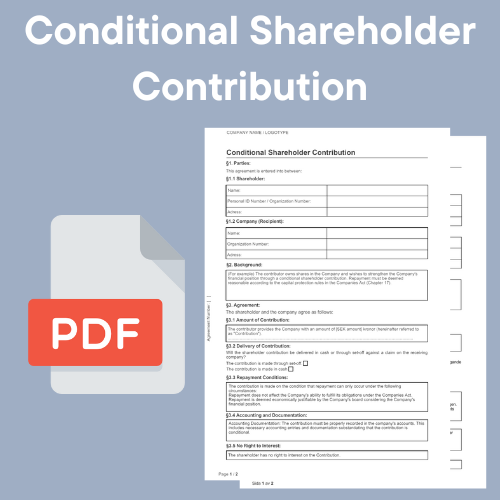Deepening in Shareholder contributions and Group contributions
Share
Deepening in Shareholder contributions and Group contributions
Table of Contents
- Shareholder contribution
- Group contribution
- Other capital contribution options
- Tax and Civil Considerations
- Practical Examples
Shareholder contribution
Definition and Types
Shareholder contribution means that the shareholders add capital to the company without receiving new shares in exchange. There are two types of shareholder contributions:
- Conditional shareholder contributions : These are paid back to the shareholders when the company's finances allow it.
- Unconditional shareholder contributions : These are not repaid but remain permanently in the company as equity.
Legal and Fiscal Aspects
According to Swedish law, conditional shareholder contributions are not taxable for the recipient, and they may not be added to the acquisition cost of the shares. Repayment of conditional contributions is treated under civil law as a profit distribution and may only take place if the company's creditor protection rules according to the Swedish Companies Act (ABL) are met. This means that the company must have sufficient distributable funds.
When a shareholder contribution is booked, the free equity account is credited, which means a direct strengthening of the company's balance sheet. For unconditional contributions, the amount can be included in the share's acquisition value, which affects taxation in the event of a possible future sale of the shares.
Group contribution
Definition and Purpose
Group contribution means that a company within a group transfers income to another company within the same group to equalize differences in results. This is a common method for optimizing the tax burden within the group.
Legal and Fiscal Aspects
Group contributions are mainly regulated in ch. 35. Income Tax Act (IL). The giver of a group contribution may deduct the contribution, while the recipient must take it up for taxation. This means that the group contribution must be reported openly in both the donor's and the recipient's income tax returns. In order for group contributions to be deductible, certain formal requirements must be met:
- There must have been an actual transfer of value.
- Subsidiaries that give or receive the contribution must have been wholly owned throughout the tax year.
- The contribution must be contained within distributable funds when it is provided from a subsidiary to the parent company.
In civil law, group contributions must be tested against the rules on profit distribution according to ABL. This means that the grant must not exceed what could be distributed as profit.
Other capital contribution options
In addition to shareholder contributions and group contributions, there are several other types of capital contributions that a company can apply to strengthen its financial position or to optimize its tax situation. Here are some of the more common options:
1. New issue of Shares
New issue means that the company issues new shares to raise more capital. This can be done in different ways, such as a directed issue or a preferential issue. New issue is useful when the company wants to strengthen its own capital without increasing its indebtedness. However, it is important to consider the risk of dilution of existing shareholders.
2. Convertible Loans
Convertible loans are loans that can be converted into shares at a later date, providing flexibility to investors and the company. This can be beneficial for companies that need capital now but want to avoid immediate stock dilution.
3. Preferred shares
Preference shares give the holders priority in distribution and liquidation but often have limited voting rights. This can attract investors looking for stable dividends without significantly affecting the ownership structure.
4. Hybrid capital
Hybrid capital combines elements of both equity and debt, such as perpetual bonds or debentures, which can improve a company's balance sheet and solvency.
5. Internal Loans
Internal loans involve the transfer of funds between different units within a group. This can help balance cash flows and finance specific projects within the group.
Tax and Civil Considerations
When considering shareholder contributions and group contributions, it is important to understand both tax and civil consequences. For example:
Shareholder contribution
- Conditional shareholder contributions are not taxable for the recipient and are not included in the acquisition value of the shares. Repayment is treated as a dividend.
- Unconditional contributions increase the shareholders' overhead amount, which can reduce capital gains tax in the event of a future sale of the shares.
Group contribution
- Group contributions enable tax equalization within the group, which can optimize the total tax burden. However, it requires careful documentation and reporting to meet tax requirements and avoid classification as tax evasion.
Practical Examples
A company that needs capital quickly to expand its operations may choose a combination of shareholder contributions and convertible loans to balance immediate capital needs and future flexible ity. A group with varying financial results between its units can use group contributions to optimize the tax situation and allocate resources efficiently.
By understanding and carefully planning for the use of these capital injections, companies can ensure a sound financial strategy that supports both short-term and long-term goals.
For further details and examples, you can visit relevant resources such as FAR and Simple Law to gain a deeper understanding of the subject.



